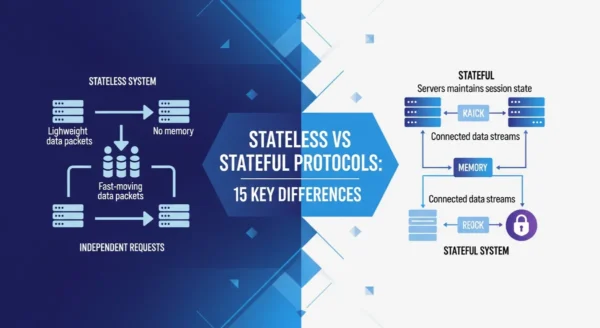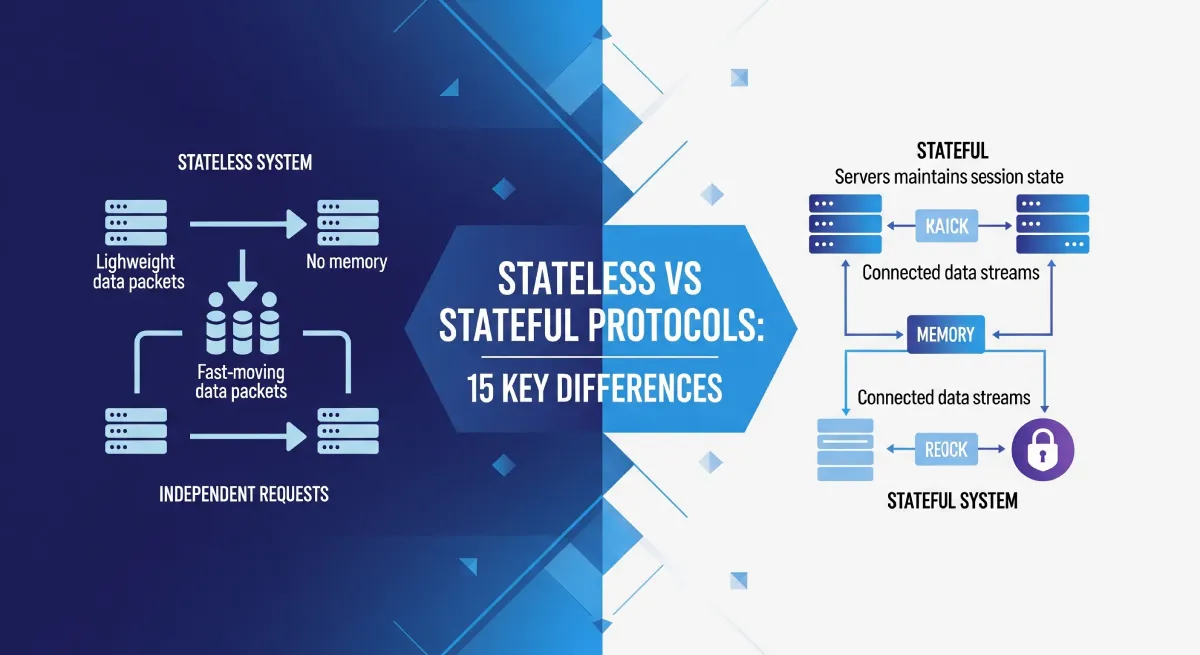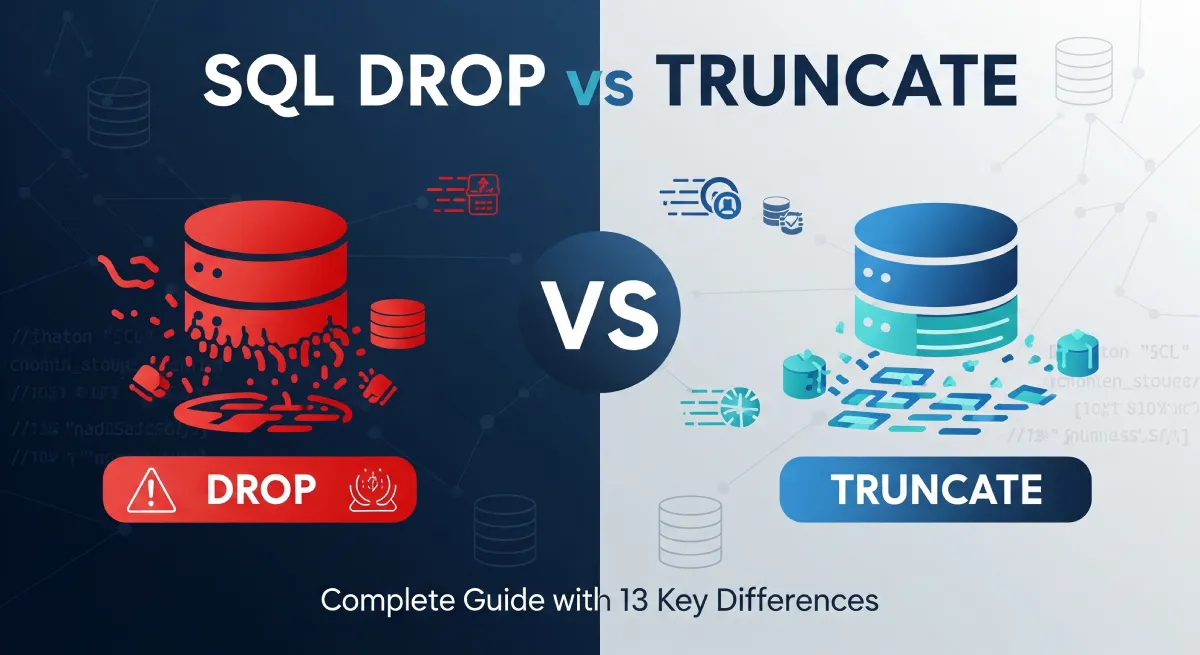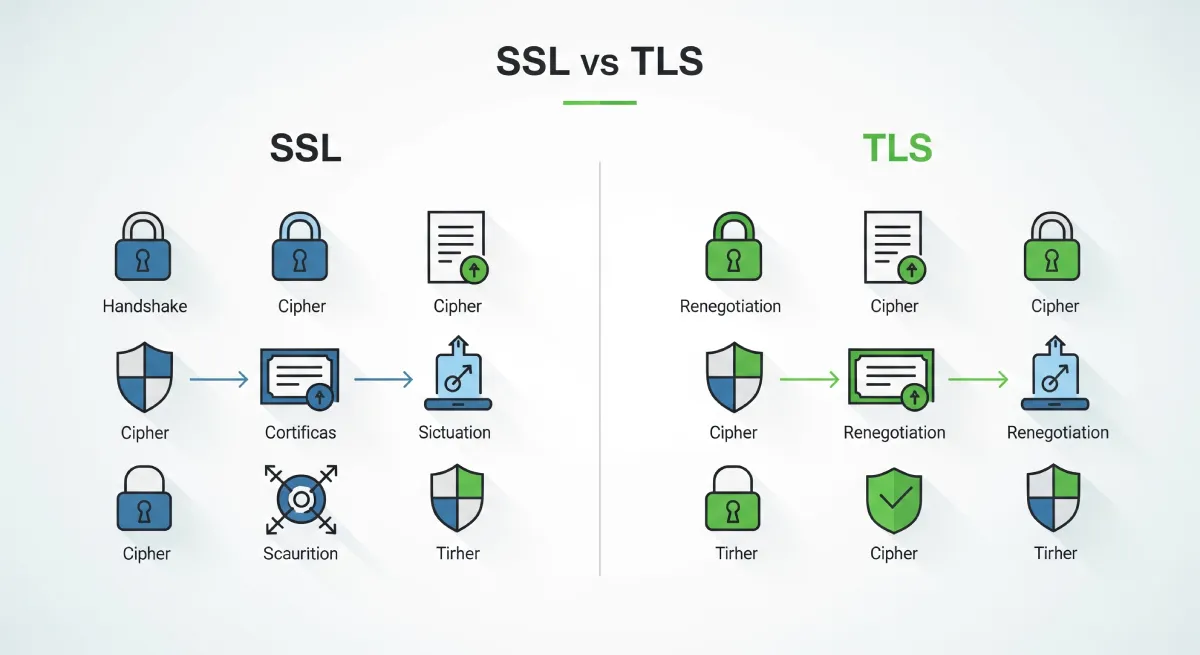Understanding Protocol Fundamentals: The Foundation of Network Communication
In network communication, protocols can be categorized as either stateless or stateful based on how they handle client-server interactions. Understanding the differences between Stateless vs Stateful Protocols is crucial for designing efficient and scalable systems that meet modern performance requirements.

Stateless Protocols: Independent Request Processing
Definition
Stateless protocols do not store client session information on the server between requests. Each request from the client to the server is treated as an independent transaction, requiring all necessary context to be included with every request.
Advantages
- Simplicity: Easier to implement and maintain as they don’t require server-side session management
- Scalability: Can easily distribute requests across multiple servers since each request is independent
- Reliability: Server failures don’t affect client operations
Disadvantages
- Increased overhead: May require additional data to be sent with each request
- Lack of context: Without session information, may lead to repetitive data transmissions
- Authentication complexity: Must authenticate every request
Common Examples:
HTTP: The most widely used stateless protocol. Each HTTP request contains all information needed for the server to process it. DNS: Domain Name System queries are independent lookups. REST APIs: Designed following stateless principles for maximum scalability.
Stateful Protocols: Context-Aware Communication
Definition
Stateful protocols maintain client session information on the server between requests. The server retains knowledge of the client’s state throughout the session, enabling more efficient and contextual communication.
Advantages
- Efficiency: Reduces data transmission overhead by maintaining session context
- Context preservation: Enables seamless interaction by remembering client state
- Enhanced user experience: Supports complex, multi-step operations
Disadvantages
- Complexity: Requires additional server resources to manage client sessions
- Scalability challenges: May encounter issues when handling many concurrent sessions
- Memory consumption: Higher resource usage for state storage
Common Examples:
FTP: File Transfer Protocol maintains client directory state and authentication. TCP: Connection-oriented protocol tracking sequence numbers and connection state. SSH: Secure Shell maintains encrypted session state throughout the connection.
Technical Characteristics Breakdown
Stateless Protocol Features
- No client session information retained on server
- Each request is independent and self-contained
- HTTP, RESTful APIs, UDP are prime examples
- Horizontal scaling is straightforward
- Load balancing doesn’t require session affinity
Stateful Protocol Features
- Maintains client session information on server
- Client state preserved across multiple requests
- FTP, SMTP, TCP are typical examples
- Requires session management infrastructure
- Load balancing needs sticky sessions
Real-World Use Cases and Applications
Ideal for Stateless
- Web applications: Search engines, content delivery
- RESTful APIs: Data retrieval and manipulation services
- Microservices: Independent service communication
- CDN services: Content caching and distribution
Ideal for Stateful
- Online gaming: Real-time multiplayer interactions
- File transfers: Secure, reliable data transmission
- Chat applications: Conversation state management
- Database connections: Transaction state tracking
15 Key Differences: Stateless vs Stateful Protocols
Aspect | Stateless Protocols | Stateful Protocols |
|---|---|---|
| Session Management | Do not store session state information | Store and maintain session state information |
| Request Independence | Each request is independent and self-contained | Requests are related and part of a session |
| Scalability | Highly scalable and lightweight architecture | May consume more resources due to state maintenance |
| Context Awareness | No knowledge of previous interactions | Aware of previous interactions within the session |
| Implementation Complexity | Less complex to implement and maintain | Require additional logic for session management |
| Common Applications | Well-suited for RESTful APIs and web services | Common in TCP-based applications like FTP, SMTP |
| Security Considerations | Enhanced security due to no persistent state | Possible security vulnerabilities with stateful operations |
| Failure Recovery | Highly reliable in case of server failure | May lead to session data loss during server failures |
| Memory Usage | Lower memory usage compared to stateful protocols | Higher memory usage for storing session state |
| Distributed Systems | Efficient for distributed systems and microservices | May introduce complexities in distributed environments |
| Load Balancing | No need for client affinity during load balancing | Require session affinity (sticky sessions) |
| Horizontal Scaling | Scaling is easier to achieve and implement | Scaling can be more challenging with state management |
| Real-time Applications | Suitable for stateless real-time services | Beneficial for maintaining conversation states |
| Data Consistency | Fewer data consistency concerns | Need to manage data consistency across sessions |
| Network Overhead | Higher per-request overhead with context data | Lower ongoing overhead once session established |
Performance Comparison: When to Choose What
Throughput
Stateless protocols typically handle higher request volumes
Latency
Varies based on context requirements and caching strategies
Resource Usage
Stateful protocols require more memory for session storage
Security Considerations and Best Practices
Stateless Security
Advantages:
- No session hijacking risks
- Reduced attack surface
- Easier to implement CORS
Challenges:
- Authentication on every request
- Token management complexity
Stateful Security
Advantages:
- Single authentication per session
- Better access control
- Session-based security policies
Challenges:
- Session fixation attacks
- Session hijacking vulnerabilities
Practical Implementation Guide
Implementation Overview
Choose the appropriate protocol based on your application’s requirements for scalability, complexity, and user experience. Consider factors like expected load, session requirements, and infrastructure constraints.
Code Examples and Implementation
Stateless HTTP Server (Node.js)
const http = require('http');
const server = http.createServer((req, res) => {
res.writeHead(200, { 'Content-Type': 'text/plain' });
res.end('Hello, World!');
});
server.listen(3000, () => {
console.log('Server running on port 3000');
});Stateful TCP Server (Python)
import socket
server = socket.socket(socket.AF_INET, socket.SOCK_STREAM)
server.bind(('localhost', 8888))
server.listen(5)
while True:
client_socket, address = server.accept()
print(f'Connection from {address}')
data = client_socket.recv(1024)
client_socket.send(b'Received: ' + data)
client_socket.close()Step-by-Step Implementation Guide
- Requirements Analysis: Evaluate your application’s need for session management, scalability requirements, and user experience expectations.
- Protocol Selection: Choose between stateless and stateful based on your analysis and technical constraints.
- Architecture Design: Design your system architecture considering load balancing, caching, and fault tolerance.
- Implementation: Develop the server logic using your selected protocol and preferred programming language.
- Testing: Thoroughly test with various client scenarios, load conditions, and failure scenarios.
- Optimization: Monitor performance and optimize based on real-world usage patterns.
Best Practices and Optimization Tips
Do’s
- Implement proper error handling and logging
- Use encryption for sensitive data transmission
- Monitor resource usage and performance metrics
- Implement timeout mechanisms for stateful connections
Don’ts
- Don’t store sensitive data in client-side sessions
- Avoid excessive memory usage for session storage
- Don’t ignore connection cleanup and resource management
- Avoid tight coupling between stateful components
Frequently Asked Questions: Stateless vs Stateful Protocols
Making the Right Choice: Key Takeaways for 2025
The comparison between Stateless vs Stateful Protocols reveals fundamental architectural decisions that significantly impact your application’s performance, scalability, and maintainability.
Choose Stateless When:
- Building web APIs and microservices
- Scalability is a primary concern
- Simple request-response interactions
- Cloud-native applications
- High availability requirements
Choose Stateful When:
- Real-time applications and gaming
- Complex user sessions required
- Continuous client-server interaction
- Transaction-heavy applications
- Personalized user experiences
Decision Framework:
Evaluate your specific requirements including application nature, expected traffic volume, security needs, and resource constraints. Consider hybrid approaches where different parts of your system might benefit from different protocol types. The key is aligning your protocol choice with your business objectives and technical constraints.
For organizations making this critical decision in 2025, consider factors such as cloud infrastructure capabilities, expected user load, security requirements, and development team expertise. Modern applications often benefit from stateless designs due to their alignment with containerization, serverless computing, and distributed system principles.
By carefully evaluating these 15 key differences and considering your specific use case, you can make an informed decision that optimizes both performance and user experience while ensuring your architecture can scale with your business growth.
Related Topics to Explore
Load Balancing Strategies
Learn how protocol choice affects load balancing decisions and session management.
API Design Best Practices
Discover how to design APIs that leverage the benefits of stateless architecture.
Microservices Communication
Explore communication patterns in distributed systems and service mesh architectures.



